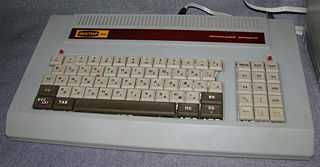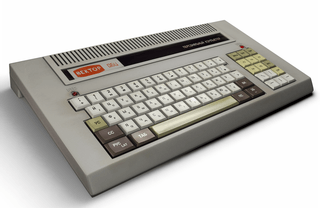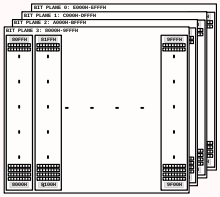Vector-06C
 | |
| Type | Home computer |
|---|---|
| Release date | 1987 |
| Operating system | Tape loader or CP/M |
| CPU | KR580VM80A @3 MHz |
| Memory | 64 KiB |
Vector-06C (Russian: Вектор-06Ц) is a home computer that was designed and mass-produced in USSR in the late 1980s.
History

Vector-06C was created by Soviet engineers Donat Temirazov and Alexander Sokolov from Kishinev, Moldovan SSR. On 33rd National Radio Exhibition the design was honoured with the grand prize. [1] Shortly after that several factories started production of Vector-06C. In 1988 Vector was honoured a prize on Exhibition of Achievements of the National Economy.
There were modifications adopting Zilog Z80 CPU or the unique Soviet KR580VM1 CPU. A commercial project called Vector Turbo+ with a Z80 CPU, clock frequency increased to 6 or 12 MHz, RAM sized up to 2 MiB and a variety of other improvements was in development. However, according to the InVector e-zine, a prototype of this system never left the work bench due to economical reasons.[2] [3]
Vector has gradually become less popular with the increasing flow of IBM PC-compatible computers on Soviet and then CIS markets. Presently Vector-06C enjoys loyal following of the few remaining fans.
Hardware
CPU: KR580VM80A (8080 clone), factory overclocked to 3 MHz (standard frequency was 2.5MHz);
Busses:8-bit data bus, 16-bit address bus;
Memory: 64 KiB RAM, up to 32 KiB can be used as video memory; 2048 bytes of ROM (512 bytes in earlier models);
Video

Video system supports following modes:[4]
- 256×256 pixels, 16 simultaneously displayed colours out of 256-colour palette
- 512×256 pixels, 4 simultaneously displayed colours out of 256-colour palette
- 256×256 or 512×256 monochrome (memory saving mode)
The frame buffer of Vector-06C is unusual for home computers. The memory is organized as 4 bit planes, palette index of each individual pixel is formed from individual bits in 4 planes. Thus the highest colour mode has 24=16 simultaneously displayed colours. The bit planes are defined as follows: a byte represents a horizontal span of 8 pixels. Next byte in video memory represents a span of 8 pixels above it and so on. Thus a bit plane in 256×256 mode can be viewed as 8-pixel wide columns, growing bottom-to-top, left-to-right; whole screen is thus covered by 32 columns.
Sound
3-channel sound system based around KR580VI53, Soviet clone of Intel 8253 timer. Third party modifications allowed use of General Instruments AY-3-8910 or YM-2149.
Storage

A generic household tape recorder was used for persistent data storage. There were 2 modulation methods used, FSK and PSK. Standard 60-minute cassette could hold:[4]
- at least 512 KiB using PSK (1500-2400 bit/s data rate)
- at least 360 KiB using FSK (1200 bit/s data rate)
FSK was primarily used in compatibility modes, which allowed reading data written on Microsha, Radio-86RK and ZX Spectrum. Native tape format used by original software is PSK.
Software

Vector-06C had no built-in software, the tiny ROM only contained a boot loader. The computer could thus only be used with external storage. Vector-06C was sold with a tape containing system utility and game programs. Third party applications could be obtained through various companies. Original software titles were games, programming languages (BASIC, Pascal, a monitor/debugger, Assembler), text and graphics editors, etc.
With optional floppy disk extension, CP/M version 2.2 was adopted. This allowed a broad range of CP/M software to be used on Vector.
It was also possible to run some Radio-86RK, Microsha, Specialist software items. Also, a method of low-level adaptation of ZX Spectrum and MSX titles was developed and some software items were ported. In particular, Vector User magazine mentions a software package consisting of a disassembler, a processor that substitutes Z80-specific instructions that 8080 was lacking with macros and a set of macros. The package was used to port several ZX Spectrum titles, namely Chess Master, West Bank, Jumping Jack .[5]
User Community
Although Vector-06C was foreshadowed by more mainstream home computers such as BK-0010, ZX Spectrum and its clones, it enjoyed a considerable loyal following of fans. Enthusiasts developed and produced software and hardware extensions for Vector. Among hardware extensions there are RAM-disk, floppy and HDD controllers, sound synthesizers, realtime clocks and others. Both commercial and public developments existed. There were electronic and hardcopy publications, most notably Invector, Vector User, Coman Info.[6] Several software contests were held among Vector users, notably DemosFan that used to take place in St.Petersburg, Russia.[7]
References
- ↑ "Front cover page". Радио. 10/1987. ISSN 0033-765X.
- ↑ NPP "Intech". "Вектор-Турбо Плюс". Vector User (in Russian) 15.
- ↑ V.P. Bykov (1997). "News". InVector (in Russian) 4.
- ↑ 4.0 4.1 "Техническая информация по ПК "Вектор"" (in Russian). Retrieved 2007-06-17.
- ↑ Makrinsky, Yuri. "Универсальный дизассемблер комманд Z80 и 8080". Vector User (in Russian). 20,21.
- ↑ "Вектор-06Ц: Электронные издания" (in Russian). Retrieved 2007-06-17.
- ↑ "Вектор-06Ц: О главном" (in Russian). Retrieved 2007-06-17.
External links
- The most comprehensive resource about Vector-06C: software, emulators, documentation, publications archive
- Technical Description of Vector-06C by Alexander Timoshenko
- Archive of Vector User and Coman Info publications on the Emulator3000 site
- vector06cc: open source Vector-06C replica in FPGA
| |||||